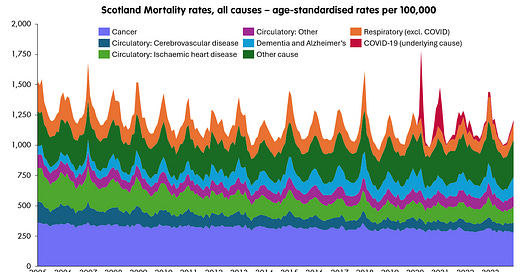One of the issue with death registrations in the UK is that they take so damn long, and this lag is getting longer.1
In England and Wales, the authorities do not even allow a death where the coroner is investigating a cause to be entered in the statistics, so you can get very strange patterns. This is a particular problem for deaths in young people, because many more of these deaths need investigation, and so those statistics sometimes do not settle down for months or years.
What this means is that if we are looking for medium-to-long-term effects from the pandemic, then even now, more than four years out, UK statistics have to be taken with care.
Scotland to the rescue
In Scotland, process is much faster; they register deaths straight away, revising later if need be, so we can look to their statistics (at least to end of 2023, when all revisions should be complete) to answer both reasonable, and less reasonable questions, such as:
Has the much-feared effect of lockdowns from 2020, causing people to miss cancer diagnosis and treatment, come to pass?
Was there anything in all the noise from the anti-vaxxers? E.g., the “turbo-cancer” claim that there has been a shocking rise in cancer deaths since 2021, when the vaccinations started.
Here we are overall - cumulative (to all causes), and then non-cumulative, to bring out the major components:
First impressions.
It’s very seasonal (except cancer). Respiratory, circulatory, even dementia. Scottish winters are hard.
It’s going down over the long-term, but overall improvement steadied and slowed to a halt from around 2014 and this is driven by a rise in “other causes”
COVID death rates were shocking, but thankfully brief (and note this is only counting where COVID was listed as an “underlying cause” of death, not where it was just mentioned on the certificate).
We can get rid of point one, and bring out points two and three are more strongly, if we smooth over 12 months to show the trends (though here we are also “smoothing out” the COVID spikes over a year)
We see that “Other cause” turn around in 2014, and rise. It is behind the overall lack of improvement. Dementia and Alzheimer’s disease has also been rising across this period, though this has steadied and even dropped recently.2
“Other cause” in Scotland
This “Other cause” category is well-studied in Scotland. The rise in death rates from 2014 was - to a large extent - was driven by drug abuse, specifically opioids. Only Scotland, the US and Canada saw such a rocket in 2014 in drug-related deaths: a full-on opioid epidemic. A chart from Colin Angus at the Sheffield Centre for Health and Related Research (SCHARR):
There is a lot more to say here about “a lost generation” (Scots - especially men - currently in their mid-40s) and on cultural and deprivation-based differences. Some of it has been said, and not much has been addressed. Although the generations are similar, it’s notable that the causes do not seem to be the same as they were in the US, with supplies being less through the abuse of legal routes by pharmaceutical companies, and more full-on illegality (opioids abused in conjunction with street benzodiazepenes).
What about Cancer?
One line that doesn’t seem to be doing much is that quiet mauve one, starting at the top and then reducing over time. It certainly looks as though it’s just might be declining overall.
But we can look closer. By age3 and sex.
Again, all kinds of interesting health and social lessons to be drawn from this (older Scottish men urgently need to stop smoking and eat better), but the overall trend can be seen to be in the right direction, particularly in the younger age groups.
The trends though, are clear - at least in the case of Scotland, any of those feared effects of delayed cancer diagnosis and treatment do not seem significant in the overall mortality numbers,4 or at least so very delayed that they have not shown up in deaths three years later.
And as for any epidemic of “turbo-cancer” starting in 2021, it is unsurprising to see that something invented by self-promoting charlatan quacks to sell vitamin supplements does not show up in the real world, but it’s reassuring to see nonetheless.
A dark irony is the dementia deaths dip in 2020-1. This, I would interpret as “COVID got them first”.
Yes, I know the age categories are massive. They’re the only age categories in the dataset.
That levelling out of the improvement trend since 2020 is indistinguishable from noise at present. It is possible that it will turn out to be the start a real effect, e.g., in younger women. But this does not carry across to older ages.








Well, frankly I’d rather Covid got me than dementia but …